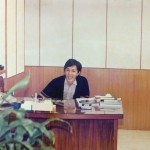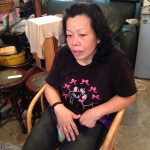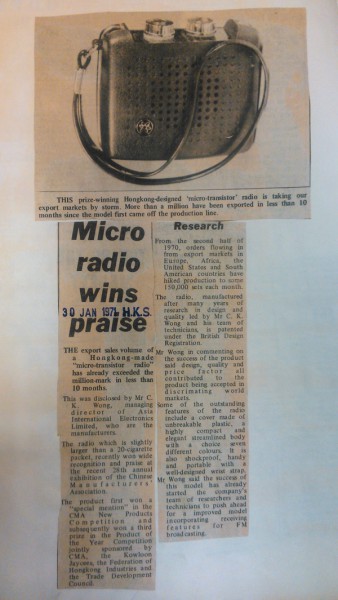Listen 來聽
Transistor Radio 原子粒收音機
Two people on the production line – Uncle Ho and Sau Ping
生產線上的兩個人- 何叔與秀屏
Listen 來聽 / Meanderings - Feature Story 咫尺 - 專題故事 / Feature: Sound Professionals 聲音職人系列
Interview & Editing 採訪、編輯、整理:Law Yuk-mui/ 羅玉梅
English Translation 英譯 : Elaine W. Ho/ 何穎雅11/03/2014
Wan Chai, Hong Kong
band, disintegration, mahjong, Nathan Road, Poland, Soviet bloc, transistor radio, 原子粒收音機, 彌敦道, 波蘭, 蘇聯, 解體, 麻雀
Editor’s note: This time we introduce two professionals, Uncle Ho and Sau Ping, who take up different roles on the production line for transistor radios. This is a recording compiled from conversation between the two during a transistor radio workshop on May 24th, 2004, and a follow-up interview. The Library would especially like to thank Ms. Choi Yuk-kuen and the Hong Kong House of Stories for their assistance and support.

Uncle Ho, 65 years old, retired. His son is a schoolmate of Him Lo, the director of Hong Kong House of Stories. He began his career as a radio technician and has worked as a manager and buyer, and in later years, a design engineer for CD players.

Sau Ping, 50-some years old. After finishing junior high school, she began working in large-scale factories. She had also worked for American companies. She has changed jobs many times and believes this is the way to keep learning new skills. “As the saying goes,” she says, “The larger the pond, the fatter the fish”.
The Golden Era
Uncle Ho: The greatest era of Hong Kong’s electronics factories was from the end of the 80s to the mid-90s. Half of Hong Kong’s factories had already moved to the north by the mid-80s, but the mainland factories could not complete the whole production process, so the most complicated and labor-intensive procedures would be done in the mainland, and afterwards the parts would be sent back to Hong Kong for assembly. At that time, foreign clients were very unreceptive to mainland Chinese manufacturing.
The so-called boom of Hong Kong electronics factories from the mid-80s to the mid-90s was due to the great rise in demand after the disintegration of the Soviet bloc and the opening up of Eastern Europe. Before the 80s, the volume of exports to Germany was quite small—about ten to twenty thousand pieces per order, usually only one shipment every six months. But after Eastern Europe opened up, Poland, Slovakia, former Yugoslavia and the Czech Republic all began importing goods from Germany, so many orders from Germany started to come in. During that period we didn’t manufacture radios only but also dual cassette players. The net cost for a dual cassette player was at most USD $16 but could sell for USD $24.
The Library: To which countries were Hong Kong manufactured radios exported? Why did export goods to the Eastern European countries have to pass through Germany?
Uncle Ho: The largest volume of exports went to the United States and Europe. But before Eastern Europe opened up, there wasn’t actually very much business with Europe. Poland, for example, didn’t have foreign exchange. Secondly, they weren’t familiar with Hong Kong people, whereas Germany and Hong Kong had always been business partners. Germany is geographically close to Poland and was a primary exchange partner with Poland. Minerals such as coal went from Poland to Germany, and material goods went from Germany to Poland. So Hong Kong’s radios were not directly exported to Poland.
Sau Ping: The strongest memory I have is the time of the embargo on the Middle East. I sat idle in the factory for three months.
Uncle Ho: That was in the 70s. My managerial job was usually five-and-a-half-day a week, and what did I do for that half day? I learned how to play mahjong.
Sau Ping: I remember something really interesting. Usually the factory was in charge of assembly, but we were so desperate at that time that we had to work on disassembly, because during the Middle East embargo finished products were not allowed for export, but sending small parts was allowed. In the end things were sent over there and reassembled. The factory managed to stay strong, so we finally made it through the Middle East embargo. During its busiest periods we were required to work overtime every night. Back then the overtime system was really good. Working from 5:30 to 8:00 p.m. was calculated as ‘one-and-a-half’.[1] Working on Sunday was also considered ‘one-and-a-half’. If we worked after 8:00 p.m. we received ‘two’. When we finished a large order, the boss would treat us to a seafood dinner, and there were birthday parties and ’hitting the night‘ [2], too. It was a really good feeling, because they relied on the workers to make money. I remember the weather in Europe used to be very cold, and we had to put the finished radios in a refrigerator for a day in order to test for problems. The Hong Kong manufactured radios usually had only three bands, but because Europe is big, we were proud to say that our factory produced seven-band radios.[3]
[1] ‘One’ is considered one hour, and ’one-and-a-half‘ refers to one hour of work paid at one-and-a-half hours’ of wage.
[2] The range from a particular frequency to another is called ‘bandwidth’ or ‘band’, and differing amounts of bandwidth can be fractioned out from between frequencies. A seven-band radio is better than a three-band radio for searching out channels. Uncle Ho’s description can be compared to the long length of Nathan Road, where if we use each storefront to divide the street into many numbers, then a bigger storefront will be easier to find.
[3] ‘Hitting the night’ means going to restaurant clubs. For more detailed reading, please see “‘Wave and Frequency’, ‘Q and Line’ and ‘Hitting the Night’: A Short Vocabulary of the Radio Manufacturing Industry”.
編按:這次介紹的兩位職人--何叔與秀屏,分別在原子粒收音機的生產線上擔當不同的崗位。此部分的內容乃摘自兩人於二零零四年五月二十四日,在香港故事館舉辦的原子粒收音機工作坊的對談錄音,並附加後續的訪問合編而成。聲音圖書館特別感謝蔡玉娟小姐、藍屋香港故事館的聯絡和幫忙。
何叔,65歲,退休人士。兒子是藍屋香港故事館負責人阿Him(盧樂謙)同學。以收音機技工展開其職業生涯,當過總管和採購,晚年轉職做CD播放機的工程設計師。
秀屏,五十多歳,初中畢業便出來工作,做過大型工廠,也做過美資公司。認為「魚唔過塘唔肥」,不斷轉工是學習新技能的一種方式。
黃金時代
何叔:香港電子廠最旺盛的年代是八十年代末至九十年代中。八十年中期,香港有一半工廠已經北移,但大陸的工廠不會完成所有的工序,最複雜、最需要人手的工序會在大陸完成,然後再將組件運返香港裝嵌當作香港製造。那時候的外國客人是非常抗拒大陸製造的。
八十年代中至九十年代中, 所謂香港電子廠最全盛時期是因為東歐開放,蘇聯解體,歐洲形成很大的需求量。八十年代前出口德國的數量是很少的, 一張一、兩萬台的訂單,通常半年才出一次貨。但東歐開放後,波蘭、斯洛伐克、前南斯拉夫、捷克全部都要從德國入貨,所以形成德國非常多的訂單。那個年代並不只製造收音機, 而是雙卡式收音機,一部雙卡式收音機成本最多十六元美金,但就可以二十四元美金。
聲音圖書館: 香港製造的收音機主要出口什麼國家? 東歐國家為什麼要經德國入口?
何叔: 主要出口美國同歐洲,東歐未開放前,歐洲的生意並不多。我舉例波蘭,第一他們沒有外匯,第二他們不熟識香港人,相反德國與香港一直有生意來往,地理上又接近波蘭。還有,他們主要是與波蘭易貨,波蘭給予德國礦產例如煤,德國就給予他們一些貨物,所以香港的收音機不會直接出口波蘭。
秀屏: 最印象深刻是中東禁運時,我在工廠呆坐了三個月。
何叔:那是七十年代,我兼管理的通常工作五天半,那半日幹什麼? 我學會了打麻雀。
秀屏: 我記得有一次很有趣,一般而言工廠都是做裝嵌的,我們慘到要拆機,因為中東禁運時製成品不批准出口,但小某部分的機件可以,結果是運到當地再進行裝嵌。最終捱過中東禁運, 因為我做的那家工廠實力尚算不俗,最全盛時期工廠規定我們每晚加班,以前的加班制度是很好的,五時半到八時這個時段是以一工半[1]計算的,星期日加班也算一工半,八時過後便給雙工。如果完成一批大訂單,老闆會請食海鮮、搞生日會、落night[3] 。那種感覺是很好的,因為他們是靠工人賺錢。記得以前的歐洲天氣好冷,我們做好的收音機會放入一個很大的冰箱一天,測試會不會出現問題。香港製造的收音機通常只有3 band[2],但歐洲地大,我們會很自豪地說我們是做7 band的 。
[1] 一工等於一小時,一工半是指加班工作1小時可以獲得1.5小時的工資。
[2] 由某頻率到某頻率是一個band,頻率中間可以分拆出更多的band,7個band的收音機會比3個band的收音機更容易搜索到頻道。何叔形容情況好比一條很長的彌敦道,假設一個鋪位連佔彌敦道幾個門牌號碼,鋪面大你便很容易找到它。
[3] 落night的意思是去酒樓夜總會,詳細內容請伸廷閱讀至《「波與頻」「Q與Line」和「落night」– 收音機製造業的幾個用詞》。

這一款香港製造,外型相當於二十支裝香煙合大小的原子粒收音機,於第二十八屆工展會榮獲好評(1971)
(圖片由香港政府檔案處,歷史檔案館提供)
The radio which is slightly larger than a 20-cigarettle packet won praise at 28th annual exhibition of the Chinese manufacturers’ association. (1971)
(Photo Courtesy of Hong Kong Public Records Office, Government Records Service)